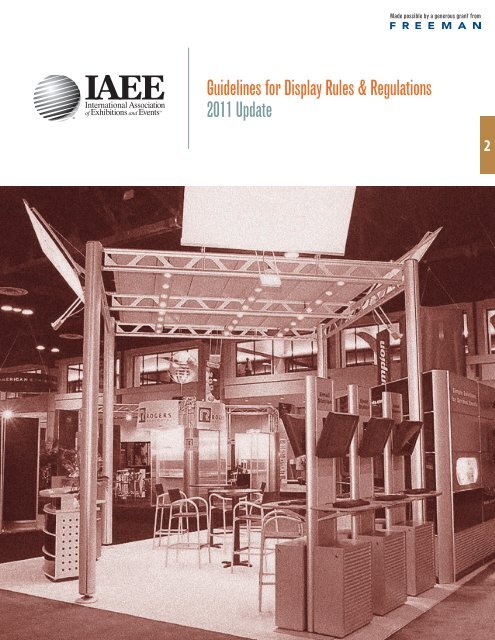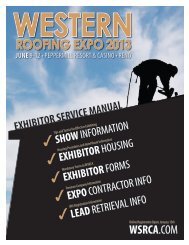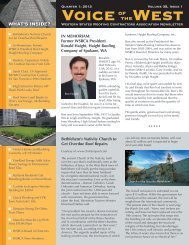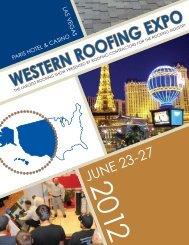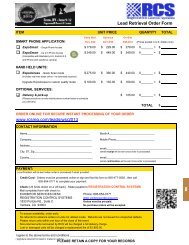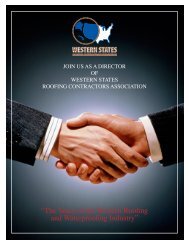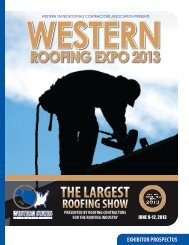IAEM Guidelines For Exhibitors - Western States Roofing ...
IAEM Guidelines For Exhibitors - Western States Roofing ...
IAEM Guidelines For Exhibitors - Western States Roofing ...
Create successful ePaper yourself
Turn your PDF publications into a flip-book with our unique Google optimized e-Paper software.
4'5'8'4'5'8'8'5'(3.048M)10'PLAN VIEW4'FRONT VIEW5'8'5'1'4'4'8'4'(1.524M)5'LEFT SIDE VIEW(1.524M)5'4'8'8'8'10' X 10' PERIMETER BOOTH5'8'8'10'5'8'10'4'8'4'4'4'1'4'4'4'8'8'4'20'4'5'8'4'4'4'4'4'1'4'(3.048M)10'(1.524M)(3.048M)10'Contents5'(1.524M)(1.524M)5'(1.219M)PLAN VIEWLEFT SIDE VIEW(3.048M)10'(1.524M)5'10'5'(2.438M)(3.048M)10'(1.524M)(1.219M)(3.658M)12'(2.438M)10'(1.524M)5'5'(1.219M)Linear Booth and Corner Booth 4AISLEAISLE(3.0484M)(3.658M)12' 10'(2.438M)(1.524M)5' 10' 5'AISLEFRONT VIEWPLAN VIEW(3.048M)LEFT SIDE VIEW10' X 10' LINEAR BOOTH10'(1.524M)5'12'(1.219M)Perimeter Booth 52(1.219M)PLAN VIEWFRONT VIEW(1.524M)(3.048M)(1.524M)5' 10' 5'AISLE(6.096M)20'(1.219M)5' 10' 5'(1.524M) (3.048M)(1.524M)20'(6.096M)AISLE(2.438M)AISLELEFT SIDE VIEW(1.524M)5'(1.219M)(1.219M)MAX. PERMISSIBLE(2.438M)(6.096M)20'10'5'20'10'End-cap Booth 6AISLEPLAN VIEW20' FRONT VIEW(6.096M)LEFT SIDE VIEW20'(6.096M)(1.524M)(3.048M)(1.524M)5' 10' 5'END-CAPWALLBOOTH(1.219M)AISLE20'(6.096M)AISLEWALLWALLAISLEAISLEMAX. PERMISSIBLE5'LEFT SIDE VIEW(1.219M)10'MAX. PERMISSIBLEPeninsula Booth 7(6.096M) PLAN VIEW20'20' 20'FRONT VIEWPENINSULA BOOTHAISLE(6.096M)20'(4.877M)16'AISLEWALLAISLEPLAN VIEW(6.096M)20'FRONT VIEW(3.048M)10'(.305M)1'(.305M)Split Island Booth 8(4.877M)16'(3.048M)10'(1.524M)(.305M)(1.219M)(2.438M)(1.219M)(2.438M)8' 4' 8'PLAN VIEWSPLIT ISLAND BOOTH(2.438M)LEFT SIDE VIEW(1.524M)5'Island Booth 9(1.219M)FRONT VIEW(2.438M)(3.048M)10'(1.524M)ISLAND BOOTH(1.219M)Extended Header Booth 10(2.438M)(1.219M)FRONT VIEW5'10' X 20' EXTENDED HEADER BOOTH10' 10'5'Other Important Considerations 115'CANOPIES AND CEILINGSIssues Common To All Booth Types 12-13Advisory Notes To Exhibition Organizers 14This edition of IAEE’s <strong>Guidelines</strong> for Display Rules and Regulations is made possible by a generous grant from2© 2011 IAEE. No cost to members in good standing for including these guidelines in exhibitor service kitsand/or in their event's rules and regulations at www.tradeshowstore.com – non member rates apply.
<strong>Guidelines</strong> for Display Rules and Regulations 2011 UpdateThe following <strong>Guidelines</strong> for Display Rules and Regulations have beenestablished by the International Association of Exhibitions and Events(IAEE). <strong>Guidelines</strong> for Display Rules and Regulations are created to promotecontinuity and consistency among North American exhibitions. They arethe model for most domestic exhibitions. It is recommended that exhibitionorganizers include a copy in the Exhibition Prospectus and/or Exhibitor Rulesand Regulations.2This revised 2011 edition of IAEE’s <strong>Guidelines</strong> for Display Rules andRegulations is offered as a resource for exhibition and event organizers touse in creating consistent and fair exhibiting standards for their events. These<strong>Guidelines</strong> afford exhibitors a maximum return on their exhibit investments.Compliance with fire, safety, Americans with Disabilities Act (ADA), and otherstate, federal or provincial government requirements has also been addressed.However, always check with a local exhibition service contractor and the facilityfor local regulations.It is IAEE’s goal that the display rules and regulations, ultimately developedby each exhibition and event organizer, shall provide exhibitors with all theinformation necessary to properly design and build exhibits, as well as plan theirbooth’s layout and content. Show organizers should present the professionalstandards expected of exhibitors. Finally, they should assure all exhibitors,regardless of exhibit size or location, an environment conducive to successfulinteraction with their audiences.IAEE is a global association that serves as the foremost authority on exhibitionmanagement and operations.<strong>For</strong> display rules and regulations specific to an exhibition or event,consult the exhibition or event organizer.This edition of IAEE’s <strong>Guidelines</strong> for Display Rules and Regulations is made possible by a generous grant from3© 2011 IAEE. No cost to members in good standing for including these guidelines in exhibitor service kitsand/or in their event's rules and regulations at www.tradeshowstore.com – non member rates apply.
Linear Booth(1.524M)5'(3.048M)10'Linear Booths, also called “in-line” booths, aregenerally arranged in a straight line and haveneighboring exhibitors on their immediate right andleft, leaving only one side exposed to the aisle.Dimensions<strong>For</strong> purposes of consistency and ease of layout and/or reconfiguration, floor plan design in incrementsof 10ft (3.05m) has become the de facto standardin the United <strong>States</strong>. Therefore, unless constrictedby space or other limitations, Linear Booths(3.048M)are most commonly 10ft (3.05m) wide 10' and 10ft(3.05m) deep, i.e. 10ft by 10ft (3.05m by 3.05m).A maximum back wall height limitation of 8ft(2.44m) is generally specified.(3.048M)10'(1.524M)5'(3.048M)10'(1.524M)5'Use of SpaceRegardless of the number of Linear Booths utilized,e.g. 10ft by 20ft (3.05m by 6.10m), 10ft by 30ft (3.05mby 9.14m), 10ft by 40ft (3.05m by12.19m), etc. displaymaterials should be arranged in such a manner so asnot to obstruct sight lines of neighboring exhibitors.The maximum height of 8ft (2.44m) is allowed(2.438M)8'PLAN VIEWonly in the rear half of (3.048M) the booth space, with a 4ft10'(1.22m) height restriction imposed on all materialsin the remaining space forward to the aisle. (SeeLine-of-Sight exception on page 8.) Note: When threeor more Linear Booths are used in combination as asingle exhibit space, the 4ft (1.22m) height limitationis applied only to that portion of exhibit space whichis within 10ft (3.05m) of an adjoining booth.(3.048M)10'(1.524M)5'(2.438M)8'10'LEFT SIDE FRONT VIEW VIEW5'(1.524M)5'28'5'4'(1.524M)5'10'PLAN VIEW(1.524M)5'(1.524M)5'(1.219M)4'LEFT SIDE VIEW5'(1.524M)5'8'4'5'4'(1.219M)8'10' X 10'Corner Booth(1.219M)4'10'4'4'(1.219M)FRONT VIEW10' X 10' LINEAR BOOTHLEFT SIDE VIEW10'4'10'(2.438M)8'A Corner Booth is a Linear Booth at the end of aPLAN VIEWseries of in-line booths with exposure to intersectingaisles on two sides. All other guidelines for LinearBooths apply.5'8'5'4'W(1.219M)4'10'4'FRONT VIEW10' X 10' LINEAR BOOTH10' X 10' LINEAR BOOTHThis edition of IAEE’s <strong>Guidelines</strong> for Display Rules and Regulations is made possible by a generous grant from4© 2011 IAEE. No cost to members in good standing for including these guidelines in exhibitor service kitsand/or in their event's rules and regulations at www.tradeshowstore.com – non member rates apply.
(3.048M)Perimeter Booth 10'(3.658M)12'A Perimeter Booth is a Linear Booth that backsto an outside wall of the exhibit facility ratherthan to another exhibit.(3.048M)10'(1.524M)5'Dimensions and Use of SpaceAll guidelines for Linear Booths apply toPerimeter Booths except that the typicalmaximum back wall height is 12ft (3.66m).PLAN VIEW(2.438M)8'(3.658M)12'(2.438M)8'(3.048M)10'(1.524M)5'(1.524M)5'LEFT SIDE VIEW(1.524M)5'(3.048M)10'4'(1.219M)(1.524M)5'24'10'(3.658M)12'12'5'PLAN VIEWLEFT SIDE VIEW(2.438M)8'8'10'5'4'5'4'(1.219M)4'4'FRONT VIEW10' X 10' PERIMETER BOOTH(1.524M)5'(3.658M)12'(2.438M)8'(3.658M)12'(2.438M)8'(1.524M)5'12'(1.219M)4'FRONT VIEW4'(1.219M)5'LEFT SIDE VIEW8'4'10'5'10' X 10' PERIMETER BOOTH4'12'5'8'4'510' X 10' PERIMETER BOOTHThis edition of IAEE’s <strong>Guidelines</strong> for Display Rules and Regulations is made possible by a generous grant from© 2011 IAEE. No cost to members in good standing for including these guidelines in exhibitor service kitsand/or in their event's rules and regulations at www.tradeshowstore.com – non member rates apply.
End-cap BoothAISLEAn End-cap Booth is exposed to aisles on threesides and comprised of two booths.DimensionsEnd-cap Booths are generally 10ft (3.05m) deepby 20ft (6.10m) wide. The maximum back wallheight of 8ft (2.44m) is allowed only in the rearhalf of the booth space and5'within10'5ft (1.52m)5'(1.524M) (3.048M) (1.524M)of the two side aisles, with a 4ft (1.22m) heightrestriction imposed on all materials in theremaining space forward to the aisle.AISLE(3.0484M)10'(1.524M)5'AISLEAISLEAISLE(3.048M)10'(1.524M)(1.524M) (3.048M)5'(3.0484M)10'(1.524M)5'5' 10' 5'(1.524M)AISLE(3.048M)10'(1.524M)5'4'(1.219M)AISLE2LEFT SIDE VIEWPLAN VIEWPLAN VIEW(1.524M)(3.048M)(1.524M)5' 10' 5'AISLEAISLE4'(1.219M)(1.524M)(3.048M)(1.524M)(3.048M)5' 10' 10' 5'(1.524M)5'(1.219M)4'(3.0484M)10'(1.524M)5'5' 10' 5'(1.524M) (3.048M) (1.524M)AISLE(2.438M)8'LEFT SIDE VIEW(1.219M)4'4'(1.219M)LEFT SIDE VIEW4'(1.219M)10'5'(2.438M)8'(2.438M)8'10'20'PLAN VIEWFRONT VIEWFRONT VIEW(1.524M)5'(1.524M)(3.048M)(1.524M)5' 10' 5'END-CAP BOOTH8'(1.219M)4'(2.438M)8'5'4'(1.219M)10'5'(2.438M)8'10'10'20'FRONT VIEW4'(1.219M)(2.438M)8'END-CAP BOOTH20'10'END-CAP BOOTHThis edition of IAEE’s <strong>Guidelines</strong> for Display Rules and Regulations is made possible by a generous grant from6© 2011 IAEE. No cost to members in good standing for including these guidelines in exhibitor service kitsand/or in their event's rules and regulations at www.tradeshowstore.com – non member rates apply.
(1.219M)Other Important Considerations(3.048M)10'Canopies and CeilingsCanopies, including ceilings, umbrellas and canopy frames, can be either decorative or functional (such as to shade computer monitorsfrom ambient light or to allow for hanging products). Canopies for Linear or Perimeter Booths should comply with Line-of-Sightrequirements. (See “Use of Space” for Linear or Perimeter Booths).The bottom of the canopy should not be lower than 7ft (2.13m) from the floor within 5ft (1.52m) of any aisle. Canopy supports shouldbe no wider than three inches 3in (.08m). This applies to any booth configuration that has a sight line restriction, such as a LinearBooth. Fire and safety regulations in many facilities strictly govern the use of canopies, ceilings, and other similar coverings. Checkwith the appropriate local agencies prior to determining specific exhibition rules.PLAN VIEW(3.048M)10'(3.048M)10'(1.524M)5'(1.524M)5'210' 10'5'(3.048M)10'(1.524M)5'(2.438M)8'(1.219M)4'(1.524M)5'FRONT VIEW8'PLAN VIEWLEFT SIDE VIEW(3.048M)10'(1.524M)5'5'4'(3.048M)10'(1.524M)5'CANOPIES AND CEILINGSHanging Signs & GraphicsMost exhibition rules allow for hanging signs and graphics in all standard Peninsula and Island Booths, usually to a maximum heightrange of 16ft to 20ft (4.88m to 6.10m) from the top of the sign. End-cap Booths do not qualify for hanging signs and graphics. Thedistance is measured from the floor to the top of the sign. Whether suspended from above, or supported from below, they shouldcomply with all ordinary use-of-space requirements. <strong>For</strong> example, the highest point of any sign should not exceed the maximumallowable height for the booth type.Hanging Signs and Graphics should be set back 10ft (3.05m) from adjacent booths and be directly over contracted space only.Approval for the use of Hanging Signs and Graphics, at any height, should be received from the exhibition organizer at least 60 daysprior to installation. Variances may be issued at the exhibition FRONT VIEW management’s discretion. Drawings should be available for inspection.(2.438M)8'(1.219M)4'PLAN VIEWTowersA Tower is a free-standing exhibit component separate from the main exhibit fixture. The height restriction is the same as that whichapplies to the appropriate exhibit space configuration being used.Towers in excess of 8ft (2.44m) should have drawings available for inspection. Fire and safety regulations in many facilities strictlygovern the use of towers. A building permit or safety lines may be required.Multi-story ExhibitA Multi-story Exhibit is a booth where the display fixture includes two or more levels. In many cities, a Multi-storied Exhibit requiresprior approval by the exhibit facility, and/or relevant local government agency, as well as show management because it is deemed to bea “structure” for building purposes. The city building department generally needs to issue a building permit based on an applicationand drawings prepared and submitted by a licensed architect or engineer. <strong>Exhibitors</strong> should obtain local building regulations early onto ensure that all time constraints are met. Exhibition organizers should be prepared to assist exhibitors in this application process.(2.438M)8'(1.219M)4'FRONT VIEWLEFT SIDE VIEW(1.524M)5'4'(1.219M)This edition of IAEE’s <strong>Guidelines</strong> for Display Rules and Regulations is made possible by a generous grant from11© 2011 IAEE. No cost to members in good standing for including these guidelines in exhibitor service kitsand/or in their event's rules and regulations at www.tradeshowstore.com – non member rates apply.
Issues Common To All Booth TypesAmericans with Disabilities Act (ADA)All exhibiting companies are required to be in compliance with the Americans with Disabilities Act (ADA), and areencouraged to be sensitive, and as reasonably accommodating as possible, to attendees with disabilities. Informationregarding ADA compliance is available from the U.S. Department of Justice ADA Information Line, (800) 514-0301,and from the ADA Web site at www.usdoj.gov/crt/ada/adahom1.htm.Structural IntegrityAll exhibit displays should be designed and erected in a manner that will withstand normal contact or vibration caused byneighboring exhibitors, hall laborers, or installation/dismantling equipment, such as fork lifts. Displays should also be ableto withstand moderate wind effects that may occur in the exhibit hall when freight doors are open. Refer to local buildingcodes that regulate temporary structures.It is recommended that all 20ft by 20ft (6.10m by 6.10m) and over exhibits require a drawing, plans or renderings,preferably digital, to be submitted to the show organizer.<strong>Exhibitors</strong> should ensure that any display fixtures such as tables, racks, or shelves are designed and installed properly tosupport the product or marketing materials to be displayed.2Flammable and Toxic MaterialsAll materials used in display construction or decorating should be made of fire retardant materials and be certified asflame retardant. Samples should also be available for testing. Materials that cannot be treated to meet the requirementsshould not be used. A flame-proofing certificate should be available for inspection. <strong>Exhibitors</strong> should be aware of localregulations regarding fire/safety and environment which must be adhered to.<strong>Exhibitors</strong> should dispose of any waste products they generate during the exhibition in accordance with guidelinesestablished by the Environmental Protection Agency and the facility.ElectricalEvery exhibit facility has different electrical requirements. However, minimum guidelines are suggested:• All 110-volt wiring should be grounded three-wire.• Wiring that touches the floor should be “SO” cord (minimum 14-gauge/three-wire) flat cord, which is insulated to qualifyfor “extra hard usage.”• Cord wiring above floor level can be “SJ” which is rated for “hard usage.”• Using zip cords, two-wire cords, latex cords, plastic cord, lamp cord, open clip sockets, and two-wire clamp-on fixtures isnot recommended and is often prohibited. Cube taps should be prohibited.• Power strips (multi-plug connectors) should be UL approved, with built-in over-load protectors.(continued on next page)This edition of IAEE’s <strong>Guidelines</strong> for Display Rules and Regulations is made possible by a generous grant from12© 2011 IAEE. No cost to members in good standing for including these guidelines in exhibitor service kitsand/or in their event's rules and regulations at www.tradeshowstore.com – non member rates apply.
Advisory Notes To Exhibition OrganizersEnd-cap Booths: End-cap Booths cause more problems between exhibitors than any other type of booth, because mostexhibitors fail to observe back wall height restrictions. Exhibition managers should be alert to exhibitors reserving End-capconfigurations to ensure they do not violate Linear Booth Line-of-Sight regulations for neighboring exhibits.Fire Equipment: Fire hoses, extinguishers, and audible or visual devices for fire alarms should be visible and accessibleat all times.Hanging Signs: Although the <strong>Guidelines</strong> indicate 16ft to 20ft (4.88m to 6.10m) as a maximum height range from the topof the sign, some exhibitions permit other heights, or have no height limit. Caution should be exercised so exhibitors willnot compete over air space for hanging signs. Most show organizers limit the height of signs.<strong>Exhibitors</strong> should be advised to install “hanging points” at the time of manufacture of the sign or display. It is alsoadvisable to have hanging signs labeled and cased separately so that they can be easily identified on site as they usuallymust be installed before other exhibit construction can begin.2Hardwall Booths: Exhibitions that provide Hardwall Booths should specify if these structures can be used for displayand attaching products.Full Cubic Content in Linear Space: It is the responsibility of the exhibition organizer to establish rules to best achievethe goals for their exhibition based on the nature of their exhibition and industry sector it serves.Cubic Content Definition: Using the perimeter lines of a booth as a guide, the exhibitor may install a booth up to theselines and utilize all the volume of space within these lines up to the maximum height permitted by the show rules asdetermined by the show organizer.It is the choice of the exhibition organizer to allow use of full cubic content in linear exhibit space or to observe theline-of-sight set-back rule. It is common at certain types of exhibitions to eliminate the line-of-sight requirement for Linear,End-Cap, and Peninsula Booths that back up to Linear Booths. This permits exhibitors to utilize the full cubic content ofthe booth.Organizers that permit use of cubic content in linear booths do so for one or all of these reasons:• Cubic content is more conducive to certain types of product displays or experiences.• Cubic Content maximizes the exhibit space and investment.• International exhibitions generally utilize Cubic Content making the show friendlier to international exhibitors.• Cubic Content reduces the need to police exhibits to enforce setback rules.Use of Cubic Content may create situations where the organizer must address exhibits that have unfinished walls. Adetermination must be made as to responsibility for finishing these areas.It is prudent for the exhibition organizer considering cubic content to examine the concerns, advantages and disadvantagesprior to putting cubic content guidelines into practice. It is often wise to consult with the exhibition’s Exhibits AdvisoryBoard or perhaps conduct a focus group of the exhibition’s exhibitors to determine their interest and gain their feedbackand support for the concept. Exhibition organizers must be proactive in communicating with exhibitors and understandingthe effect it will have on the exhibition.This edition of IAEE’s <strong>Guidelines</strong> for Display Rules and Regulations is made possible by a generous grant from14© 2011 IAEE. No cost to members in good standing for including these guidelines in exhibitor service kitsand/or in their event's rules and regulations at www.tradeshowstore.com – non member rates apply.
Advisory Notes To Exhibition Organizers (continued)Perimeter Openings: Large peninsulas and islands with long high walls can create a “tunnel-like” effect. <strong>Exhibitors</strong> maybe required to install a minimum 6ft (1.83m) opening every 30ft (9.14m).Pipe and Drape: These are commonly used at exhibitions to define exhibit space. Exhibition organizers often include intheir rules and regulations that this equipment is not intended as a display fixture. Therefore, product and signs should notbe attached or affixed. Measurements of booths must allow for size of pipe on sides and back.Product Height: Some exhibitors have products that exceed display height restrictions. Exhibition organizers shouldestablish guidelines for displaying such products. <strong>For</strong> example, some exhibitions require that these exhibitors reserve onlyperimeter space. Products exceeding height restrictions for Islands and Peninsulas are usually permitted, providing theyare displayed in operating mode, and the names and logos, etc. on the product are as it is sold.2Vehicles: Rules vary depending on the facility, but generally it is required that vehicles on display have no more thana one fourth tank of gas. The filler cap should be sealed and the batteries disconnected. External chargers are usuallyrecommended for demonstration purposes. Keys should always be surrendered to show management while participatingin an exhibition or event.Height Variances: Height Variances may be issued for all types of booths. However, in a linear booth, the back side ofany structure over 8ft (2.44m) must be free of trademarks, graphics, and/or logos.Environmental Responsibility: Exhibitions, by their very nature, create waste. Properly managed, exhibitions can recycleexcess materials and supplies in useful and meaningful ways, and they can do so using methods that result in minimizedimpact on the environment. Exhibits should utilize recycled, renewable and energy efficient materials whenever possible.This edition of IAEE’s <strong>Guidelines</strong> for Display Rules and Regulations is made possible by a generous grant from15© 2011 IAEE. No cost to members in good standing for including these guidelines in exhibitor service kitsand/or in their event's rules and regulations at www.tradeshowstore.com – non member rates apply.


